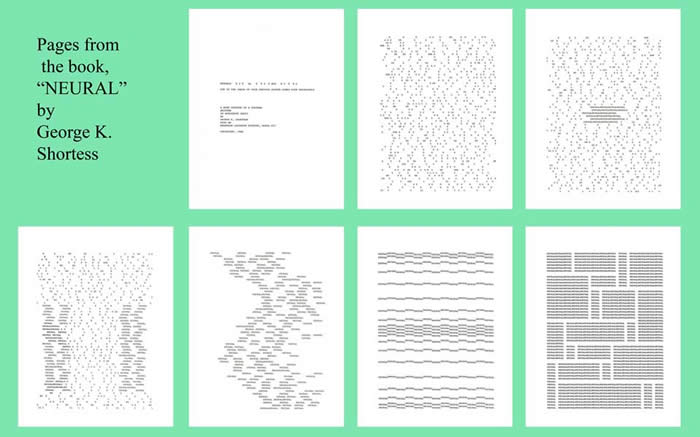
My Books
My earlier approach to artist books was to use them to express artistic ideas that I was not able to express in traditional painting. Later books have become more like installations in which there is sometimes interaction between the artwork and the viewer. Two of my earlier, computer-generated books, NEURAL and ITHINK (See Below), have recently been acquired by the Museum of Modern Art in New York.
Computer-generated books:
These earlier computer generated books reflect ideas about the nervous system and perceptual experience. In each, there is a progression from disorder to order, a reflection of the way our nervous systems organize a confusing world. Further, each copy has a unique sequence of letters and words within the same overall structure, since each is printed separately under computer control. This reflects the individual differences of our nervous systems within the same larger structure.

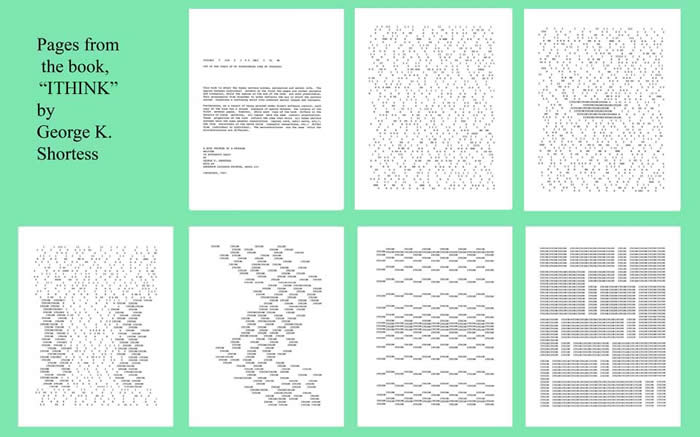
Below is a portion of page 4 of ITHINK, in order to provide an idea of the actual printed material.
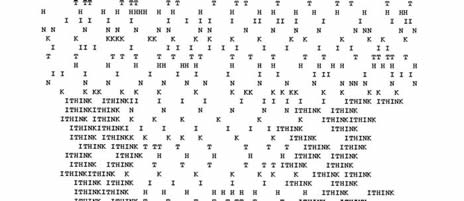
2012 A Proposal for The Book to Be.
As often demonstrated, the physical act of drawing is a powerful and useful tool for understanding the world and our relationship to it, even in this electronic age. This proposed interactive installation will celebrate this process of understanding.
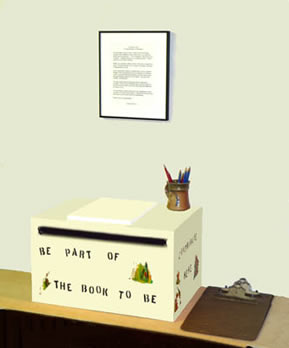
This is a proposal for a book work, or works, to be created as a result of viewer participation. It is adaptable to a variety of spaces and subject matter. In all cases however, for a defined period of time viewers will make contributions related to some predetermined subject matter of the particular situation selected, emphasizing graphic material. After the period is over, I will edit and create one or more artist books from the contributed material. The form of the books will depend on the material.
I would provide pencils, paper and clipboards for people to make their contributions. They could express concrete ideas or more nebulous feelings. They would be encouraged to use drawings and diagrams, but text could also be submitted. These contributions would not be expected to be finished work, since I would develop and edit the work. It would be “democratic art” - what might be called “everyperson book artists.”
One form of the physical arrangement is illustrated here. Once an entry is submitted through the slot it cannot be seen by others or retrieved by the submitter. Above the box is a framed set of printed instructions, which will vary according to the specific circumstances.
2011 Multiple, Limi ted Unique - Center for Book Arts, NYC, NY. This exhibition is a selection from the Center's collection. It is the culmination of the three-year effort of the Center's Collections Initiative, which includes the in-depth cataloguing and preservation of the extensive collection of artist books, prints,catalogues, and ephemera.
ted Unique - Center for Book Arts, NYC, NY. This exhibition is a selection from the Center's collection. It is the culmination of the three-year effort of the Center's Collections Initiative, which includes the in-depth cataloguing and preservation of the extensive collection of artist books, prints,catalogues, and ephemera.
I have donated the five 1986-87 computer generated books to the Center. One of these books, "MENTAL" was included. It is shown in the image from the exhibit at the right, as the cascading pages in the left portion of the display case.
The exhibit traveled to the Minnesota Center for Book Arts (Winter 2012), the Museum of Printing History (Spring/ Summer,2012),, Lafayette College (Fall 2012) and The Book Club of California (Winter 2013). The exhibition was promoted and described online by DOMUS, from whose site the photo was taken.
.
2010 A Tribute to the Art of Cutting was made specifically for the exhibition” I’ll Cut ThrU” which was held at the Center for Book Arts, NYC in 2010,and then traveled to Sarah Lawrence College. The interactive sculptural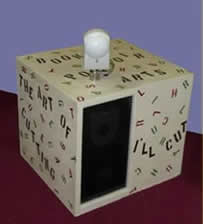 book was designed as an introduction to the exhibit of books, all of which involved cutting in some fashion. The sculpture was placed at the entrance to the exhibit, where people triggered it as the came in. This interactive sculpture housed a computer, sampler and speaker with the sensor mounted on top. When triggered the sculpture produced random sequences of sounds. These sounds included both voice segments and sounds made by cutting machines. The voice segments were edited versions of comments about the exhibit, recorded in interviews with the two curators of the exhibition. In this piece the sound segments overlapped a great deal, creating more of a texture of sound than clearly recognizable words.
book was designed as an introduction to the exhibit of books, all of which involved cutting in some fashion. The sculpture was placed at the entrance to the exhibit, where people triggered it as the came in. This interactive sculpture housed a computer, sampler and speaker with the sensor mounted on top. When triggered the sculpture produced random sequences of sounds. These sounds included both voice segments and sounds made by cutting machines. The voice segments were edited versions of comments about the exhibit, recorded in interviews with the two curators of the exhibition. In this piece the sound segments overlapped a great deal, creating more of a texture of sound than clearly recognizable words.
Some of the comments were:
1) Cut out dolls - the prints called topsy turvey
2) Conception, process, I’ll cut through conceived in duality
3) The idea of cutting, the objective of cutting, carving, applications of cutting
4)Pochoir, I’ll cut through, pochoir carving, cutting, altered book and new media
5) Show coherently or cohesively how different methods of cutting can create intellectual, meaningful,
content-driven art objects
6) With the print, you see the cutting action, the marks, through the wood, made by the tools on the block
7) She is trying to capture the minority cultures of China – this concept of memory and loss
8) All artists do books - something that contains information - all artists want to make a book
9) The concept of the book and book arts within the broader context of contemporary literary arts
2006 How,Why,Where,What:Four Trees of Brown
This book is a book combining my work with installations with the concept of a book. 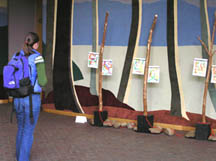 The photographs ar
The photographs ar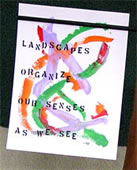 e of the book installation as part of the exhibit: Meraviglia: Innovations in the BookArts at Lafayette College in 2006.
e of the book installation as part of the exhibit: Meraviglia: Innovations in the BookArts at Lafayette College in 2006.
This book installation is a series of four bare tree trunks in a row. Each is 7 feet high, and 2-3 inches in diameter with a heavy base to stabilize it. Each trunk ![]() has two, one-foot dowels that extend from the trunk, horizontal to the floor. Pages of acid free paper (8 x 11 inches) are attached to the dowels. These book pages are printed with free form poetry about the landscape as a metaphor for living, each tree asking one of the four questions in the title. Viewers walk past all four trees to read the book.
has two, one-foot dowels that extend from the trunk, horizontal to the floor. Pages of acid free paper (8 x 11 inches) are attached to the dowels. These book pages are printed with free form poetry about the landscape as a metaphor for living, each tree asking one of the four questions in the title. Viewers walk past all four trees to read the book.
1991-2 How Do You Feel About AIDS?
This computer printed book reproduces the written responses from my 1990 installation, "How do you feel about AIDS", at Open Space Gallery in 1990. People wrote their responses on file cards and the attached them to the installation so subsequent viewers could read them. Some orange response cards are shown in the image of the installation below on the left. These written responses were then scanned and edited using computer software. Pages were printed and bound in tradition book format as a record of the exhibition. Images of selected papers from the book are below. 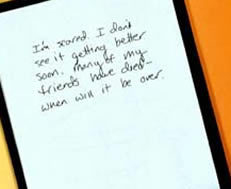
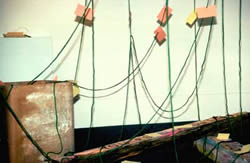
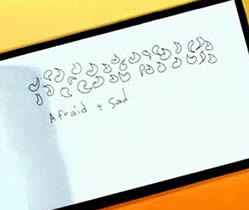
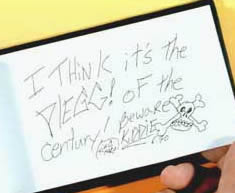
1989 - What Is? - Computer-based interactive book and sculpture.
This next book is an interactive sound and video sculpture, developed with a 1988 Fellowship Grant from the Pennsylvania Council on the Arts. It expands the nature of books as sequences of experiences controlled by the viewer. In the work, pages are not fixed, but result from dynamic viewer-computer interaction and are displayed on a video monitor. Hard copy outputs of pages are made for the viewer with a printer. Viewers can activate sensors by moving their hands in the black opening beneath the monitor and can thus modify the letters, words, and colors, as well as the visual structure of the book pages.
The viewers can also type words and sentences on the keyboard. Messages and questions appear on the monitor as guides, and the computer program modifies the answers, depending on the sensor input and the computer program. All of these inputs are stored on the computer's hard disk for documentation. The computer's comments and guiding questions focus on the nature of art. In this form the book becomes more of an interactive process than a conventional book since the page structure and content are partly determined by the reader.
home | installations | exhibits | errata | contact
© Copyright George K. Shortess. All rights reserved.